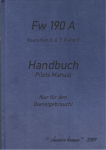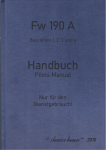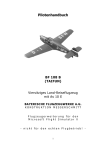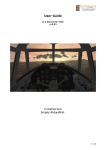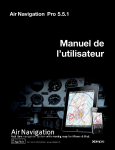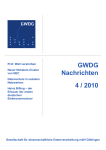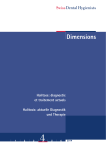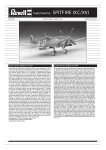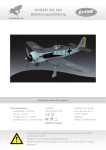Download Classics hangac Focke Wulf Ta 152 H User manual
Transcript
1
Focke Wulf Fw 190 A
Aircraft Expansion for Microsoft Flight Simulator X
User Manual
February 2010, Version 1.0
2
A production of
Mathias Pommerien
Lüneburger Str. 21
29525 Uelzen
Germany
support @classics-hangar.de
http://www.classics-hangar.de
System Requirements:
Windows XP SP 2 , Windows Vista or Windows 7,
Microsoft Flight Simulator X @ Service Pack 2, Gold or Acceleration Expansion Pack,
Dual Core Processor @ 2.4 GHz or better
2GB Virtual Memory
512 MB DX9 or DX10 Graphics Card
300 MB free disc space for the executable, 900 MB free disc space for the installation.
Copyright 2009 /2010 Classics Hangar Mathias Pommerien, Lüneburger Str. 21, 29525
Uelzen, unless stated otherwise. All rights reserved. Sound module licensed to Classics
Hangar by Bill Leaming.
No re-use/re hosting/redistribution of any part of this work is permitted without prior
written permission by Mathias Pommerien. Microsoft Windows 2000, Windows, XP, Vista,
Windows 7 and Flight Simulator are either registered trademarks or trademarks of
Microsoft Corporation in the USA or other countries.
3
Table Of Content
Page
Introduction.......................................................................................................................
Features...........................................................................................................................
Installation........................................................................................................................
Texture Configuration
Exterior Textures...................................................................................................
Interior Textures, Texture Manager....................................................................
First Run, Security Warning...........................................................................................
Notes for Repainters, Paint Kit......................................................................................
Development History
Early Development.................................................................................................
Fw 190 A-3...............................................................................................................
Armin Faber's Fw 190 A-3.....................................................................................
Fw 190 A-4...............................................................................................................
Fw 190 A-5...............................................................................................................
Fw 190 A-8...............................................................................................................
Fw 190 A-9...............................................................................................................
Fw 190 Today, the Flugwerk Fw 190 A-8/N (not included to this package)
The Cockpit.......................................................................................................................
Operating the FS Aircraft, general notes......................................................................
Flying at Night..................................................................................................................
Cockpit Diagrams............................................................................................................
Specific Operation Procedures
Fuel Management...................................................................................................
Gear Operation........................................................................................................
Flaps Operation, Trimming....................................................................................
Radio Operation.......................................................................................................
Manual RPM Adjustment, Prop Feathering.........................................................
Canopy and Canopy Emergency Release............................................................
Main Flight and Engine Instruments, description inclusive unit conversion tables
and operational limits.....................................................................................................
Changing or removing Payloads, dropping bombs.....................................................
Liveries.............................................................................................................................
Credits...............................................................................................................................
5
5
6
4
6
7
8
8
9
11
11
12
13
13
14
14
15
15
16
17-23
24
25
26
27-34
35
35
36-40
41-44
45-55
55
Introduction
Included in this Flight Simulator X add-on package are renditions of the WW II Luftwaffe’s
second major fighter aircraft, the Focke Wulf Fw 190 A.
Fly the early A-3 and A-4 fighters, make the transition to early blind flying and radio
navigation with the sleek A-5, make your way to the versatile A-8 and master the 2200
horse powers of the A-9, the final version of what many believe was one of the finest
piston aircraft that ever flew the skies.
Each variant has a unique 3d virtual cockpit with fully operable and working 3d
instrumentation, re-creating German period micro mechanics in a depth never before
seen in a Flight Simulation.
The flight physics for each aircraft are captured uniquely, making full use of Flight
Simulator's advanced 6DoF aerodynamic equations, including accurately modelled coupled
Moments of Inertia calculations, giving the virtual pilot a distinct sensation of flying in air.
Features
-
5 highly detailed FSX-native exterior and interior models,
-
21 historical exterior liveries in 2048 pixel high resolution textures supporting
bloom, specular, bump mapping and self shadowing.
-
Option to use extremely detailed 4096 pixel interior textures, configurable using an
external texture manager application.
-
Unique flight physics for each sub variant, highly accurate real world physics based
flight modelling provided by AvHistory, created using AvHistory.org’s USAF
DATCOM based 1% Aerodynamics, Stability and Control aircraft development
software.
-
Custom engine damage and aircraft system modelling.
-
Drop tank and bomb payload.
-
Highly detailed and fully functional virtual 3d cockpit
-
Detailed and accurate set of German 3d gauges.
-
Working reflector gun sight.
-
Custom tailored engine and cockpit sounds.
-
Scalable realism using the “Just Fly” utility.
5
Installation:
Drop in that CD and let it do it's job.
Texture Configuration
Exterior textures:
The exterior textures are created in a 2048 by 2048 pixel resolution to allow for a higher
detail than the default FSX textures while at the same time keeping the all over number of
textures low to maintain good performance.
Enabling FSX to make full use of these high resolution textures requires a little editing to
the FSX configuration file. After the installation is complete please proceed as follows.
XP Users:
Make sure that Windows is configured to display hidden folders.
Open an Explorer window and browse to a file called fsx.CFG.
This is usually located at
C:\Documents and Settings\User name\Application Data\Microsoft\FSX\fsx.CFG
open the file using a text editor and locate the following line:
TEXTURE_MAX_LOAD=xxx
Change the value so that it reads like
TEXTURE_MAX_LOAD=2048
Save and exit.
Vista and Windows 7 Users:
Make sure that Windows is configured to display hidden folders and that you have
administrator rights. Open an Explorer window and browse to a file called fsx.CFG.
This is usually located at
C:\Users\username\AppData\Roaming\Microsoft\FSX\fsx.cfg
open the file using a text editor and locate the following line:
TEXTURE_MAX_LOAD=xxx
Change the value so that it reads like
TEXTURE_MAX_LOAD=2048
Save and exit.
6
Interior Textures:
By default the Fw190A comes with a high quality set of interior textures in 2048x2048 pixel
resolution. However, while our default resolution should satisfy most users there is an
option to display the major cockpit surfaces in even crisper detail using 4096x4096 pixel
resolution textures.
Please note this option should only be used if you have a fairly recent PC system that is
able to run FSX in conjunction with highly detailed third party add-ons without problems.
Note this feature does not require the FSX.cfg's TEXTURE_MAX_LOAD entry to be adjusted
to 4096. TEXTURE_MAX_LOAD=2048 will do fine.
How to use:
A short cut to the utility is located in Start Menu\Classics Hangar\Fw190A\
To enable the high detail cockpit textures just click the button "High Resolution" and close
the program.
If you experience problems with this configuration or you wish to free up some computing
resources re-run the program, click on "Default Resolution".
7
First Run:
When you start FSX for the first time after installing “Fw 190 A- The Late Variants”
a security warning will pop up:
Please answer this with “run”
In the following dialogue you will be asked if you wish to add
ClassicsHangar_XMLSound.gau to the list of trusted software.
Please answer with “Yes”.
Repainter Notes:
There is a layered paint kit in psd format included to make easier the creation of user
made repaints.
It’s located in “FSXroot\Classics Hangar\Fw190A\Paintkit”
8
Early Development
By early 1938 the Focke Wulf factory in Bremen was ordered by the German Air Ministry,
the Reichsluftfahrtministerium (RLM), to develop a second fighter for the Luftwaffe as a
backup in case problems should arise with the Messerschmitt Bf109.
The new aircraft was to follow a different approach from the ground up than the concurring
Messerschmitt design.
Kurt Tank’s (Technical Director of the Focke Wulf factory), vision was that of an aircraft
with a high degree of reliability and ease of production in mind, easy serviceability by
crews with a low training standard at hastily built frontline airfields. Control harmonization
and flying qualities were to be well balanced so that inexperienced pilots would get
accustomed to the plane without problems. Contrary to the development mainstream in
Europe, a radial engine had been choose to power the new aircraft.
Expected shortages of liquid cooled engines played the ball into Kurt Tank’s court who was
favouring the radial engine anyway. The Hughes H-1 which he watched on return from it’s
epic flight in New York, apparently left Tank impressed. Also the Luftwaffe experiences in
fighting the robust I-16 Rata during the Spanish civil war where not forgotten.
In charge of the constructional work was Rudolf Blaser and ten month after the contracts
had been signed the first prototype of the then so-called Fw190 made it’s maiden flight by
1. June 1939 with Focke Wulf’s Chief Test Pilot Hans Sander at the controls.
The Fw 190 V-1 was powered by an 18 cylinder BMW 139 delivering 1500hp.
The aircraft was an all metal, low wing, cantilever monoplane of a semi monocoque
construction. The tail was a separate section and the radial engine was elegantly blended
into the fuselage lines. Two self-sealing fuel tanks where located under the cockpit. The
nearly frameless sliding canopy was a first of it’s kind and granted very good all-around
visibility, occupied only by the massive radial engine.
The wings were of a two-spar construction with the main spar running through the entire
length of the wing. The entire assembly was attached to the fuselage as a whole. The
hydraulically operated gear was fully inwards retractable and had a wheel track of 3.5
meters / 11.5 ft. All following Fw190A used an electrically driven gear.
Stick and pedal forces where brought to the control surfaces by rods and not by cables as
it was common use until then. The horizontal tail plane was trimmable by an electrical
motor as a whole. No other pilot-adjustable trim surfaces where provided. Static trim tabs,
so called “Bügelkanten” were adjustable on the ground.
After several changes, including an engine change to the new BMW 801 C, orders were
given for a pre-series Fw 190 A-0.
6 of those machines had been sent to the Luftwaffe test centre at Rechlin
(Erprobungsstelle Rechlin) by March 1941. Parts of II./JG 26’s ground staff and pilots
around Technical Officer Karl Borris under command of Oberleutnant Otto Behrens where
transferred to Rechlin to test the aircraft’s combat and service qualities.
The pilots were impressed!
The Fw 190 was light on the controls and responsive, agile, fast and manoeuvrable.
Particularly, roll rates were exceptionally good. Take off and landings were easy, granted
to the wide wheel track with no tendency to break out.
Balancing was superb with very low Centre of Gravity changes throughout the envelope,
thus only minimal trim changes to the horizontal tail plane where required as load
9
changed. Unlike the concurring Messerschmitt design and the opposing Spitfire the Fw190
remained manoeuvrable at extremely high speeds. The plane reached 955kph in a dive
during a test flight later in the war and remained controllable with no harm to pilot and
machine.
Mock combats against captured planes clearly showed that the Fw190 was superior to
anything the allied had in their inventory.
The ground crews found the plane to be easily serviceable. Every part of the plane was
accessible through flaps. Engine changes where fast and simple. It’s sturdiness let the
plane survive belly landings without serious damage.
Everybody agreed that the airframe was a great hit.
There where however serious issues with the BMW 801 engine that almost caused the
cancellation of the entire project. The pistons seized at warm-up or when idling for too
long. Burst fuel and oil pipelines caused the ground crews to always have the fire
extinguisher at hand when a pilot was about to climb into the cockpit. Broken oil coolers
where a familiar sight. The pilots never lost sight of the runway when in the air.
Otto Behrens and his crew managed to convince the RLM that all of the failures where
fixable and mostly caused by peripherals, so tests continued and the Fw 190 eventually
reached serial production status.
By mid 1941 Nazi Germany turned it’s war effort towards the Soviet Union.
Only two fighter units remained at the channel coast in France and the Low Countries,
Jagdgeschwader 2 and 26, being badly in need of replacement equipment. The RLM,
without waiting for the final Rechlin test results and the engine troubles not yet ironed out
ordered production of the Fw 190 A-1 to begin.
II./JG 26, still having mostly the somewhat aged Messerschmitt Bf109 E in it’s inventory,
was the first unit to convert to the new Fw 190, even though combat trials of the fighter
were not yet completed.
The first production badge arrived at Paris-Le Bourget by late summer 1941 where the
conversion and final trials took place. This conversion proved to be a catastrophe.
Almost every flight ended with an engine failure, but more often than not the planes didn't
take off at all.
The engines died or the ammunition exploded at the engine’s warm-up run.
The repertoire of failures lasted from burst fuel pipelines over broken oil coolers to piston
seizure. The conversion was basically a re-run of the initial Rechlin tests.
It took about 50 modifications to bring the Fw 190 up to frontline serviceable conditions,
and it can be credited to the will and persuasive power of Otto Behrens that the project was
not cancelled.
This persistence paid off when the Fw 190 made it’s combat debut over Dunkirk by
September 1941. The aircraft proved to be clearly superior to the opposing Spitfire Mk V in
every respect except horizontal turn radius.
The Fw 190 could out-climb, out-run, out-dive and out-manoeuvre the Spitfire. So superior
was the Fw 190, that pilots could engage and disengage combat at will.
The attrition rates amongst the RAF Spitfire pilots rose dramatically. On the other hand,
thermal problems with the BMW 801C engine remained critical so that the Fw 190 pilots
where initially limited to sorties along the continental side of the channel coast.
10
Fw 190 A-3
Production of the A-2 began by August 1941 at the Ago Factory Oschersleben parallel to the
A-1 production at Focke Wulf Bremen.
One of the first things to be criticised by the pilots was the comparably weak firepower of
the Fw 190 A-1. This was addressed for the A-2 by replacing the wing root machine guns
with a pair of Mauser MG 151/20 20mm cannons.
The outboard wing’s MG FF cannons were from now on optional as a Rüstsatz, but were
delivered with every aircraft.
The A-2 received the improved BMW801C-2 engine rated at 1600 PS / 1578 hp at takeoff. To
improve the thermal difficulties with the 801 the series also saw the addition of fixed
cooling slots just aft of the left and right exhaust stacks. The electrical gear motor was
replaced with a more powerful type and the wingspan was increased to 10.51 m / 34.48 ft
and remained unchanged until the last reincarnation of the line entered service, the Ta152.
As the A-2 entered production a new improved engine became available, the BMW 801 D-2,
rated at 1730 PS / 1706 hp at takeoff.
The implementation of the engine led to the parallel production of both the A-2 with the C2 engine and the Fw 190 A-3 with the D-2 engine.
Both aircraft were otherwise identical so that a distinction of both types from photographs
can’t be reliably performed unless the production number of the aircraft is known.
However persisting problems with overheating D-2 engines forced the Luftwaffe to lock
manifold pressure to 1.32ata so that the Fw 190 A-3 initially flew approximately 200 horse
powers short of it's potential.
Some A-2s were eventually renamed to A-3s after repair and engine replacement with
the D-2 aggregate.
The BMW 801 slowly left the teething problems behind and reached an average operational
life of about 120 hours.
A total of approximately 909 Fw 190 A-2 and A-3 was produced between August 1941 and
September 1942 at the Focke Wulf plants Bremen and Marienburg, Ago Oschersleben,
Arado Warnemünde and Fieseler Kassel.
The Fw 190 now served with JG 1, JG 2, JG 5 “Eismeer”, JG 26, JG 51, SG 1 and SG 2.
Armin Faber’s Fw 190 A-3
By mid 1942 the moral of the Royal Air Force pilots was seriously affected by the success
of the new German fighter.
A desperate commando raid on a German airfield in France was planned with the goal to
hijack an intact example of this wonder weapon. However, luck was with the British when
Oberleutnant Armin Faber of Stab III./JG 2 landed his Fw 190 A-3, Werknummer 313 in
error at Pembrey South Wales on 23. June 1942 after combat with Spitfires.
The Fw 190 was immediately disassembled and transferred to the Royal Aircraft
Establishment where it was closely examined under the foreign equipment registration
MP 499.
In about 9 flying hours the machine was explored before it was handed over to the Air
Fighting Unit by 13.7.1942 for tactical trials.
11
The trials confirmed what was already known as far as the comparison to the Spit Mk Vb
goes but also revealed the weaknesses of the BMW 801 engine. The engine would lose
performance rapidly above 25.000ft.
Beside that, it was obviously de-rated and didn’t deliver it’s full power of 1.42 ata. In fact, by
that time the D-2 was not considered 100% reliable by the RLM and manifold pressure was
locked at 1.32 ata.
As an immediate answer, guidelines for combat with the Fw190 where filed, basically to
the extent that combat had to be avoided when the Spitfire Mk V pilot didn’t have an initial
advantage in altitude and speed.
Diving had to be avoided under any circumstances as the Spit wouldn’t have a chance to
escape. Instead a shallow descent at full throttle towards the homeland was advised so
that the attacking enemy would be forced to leave the combat area if he wanted to follow.
Production of the improved Spitfire Mk IX would be at full steam by June and would almost
bring the RAF pilots back to equals as the engine performance of the Mk IX was
comparable to that of the Fw190A. Yet the Fw190 would hold the edge in manoeuvrability.
The capture of Armin Faber’s Fw 190 is commonly marked as the end of the Luftwaffe’s
one-year supremacy over the channel front.
Whether the results of the trials where such a surprise might be debatable since the
improved Spit Mk IX was already well underway. However, the propaganda effect can’t be
under-estimated as it restored the RAF pilot’s faith in their own abilities. The Mk IX did not
surpass the Fw190’s performance but it helped to level the field and successfully ended the
Luftwaffe’s un-shadowed days of victory over the channel.
Armin Faber’s Werknummer 313 remained the only Fw 190 A in pure fighter configuration
to be captured intact by the allies for the duration of the war. All other captured aircraft
were either of the long range bomber or fighter bomber configuration.
Fw 190 A-4
The implementation of the new VHF radio FuG 16 eventually led to the new variant Fw 190
A-4 which was produced between June 1942 and August 1943 in approximately 974
samples.
The FuG 16 used a “T” shaped antenna which required a re-design of the vertical tail,
recognizable by a vertical “sting” on top of the fin.
The fixed cooling slots where replaced by adjustable flaps at some point during the
production run and were operated by a crank located at the cockpit’s lower forward panel.
The armoured headrest saw replacement with a larger type.
Even though all sort of conversions had already been tested and used operational in small
numbers on previous versions, it wasn’t before the A-4 that bombs became more
commonly carried on the Fw 190. This were usually unnamed modifications. The bombs
were carried on an underbelly ETC 501 rack and electrically fused by an apparatus right
under the forward panel.
Dedicated fighter bomber and long range fighter bomber versions have been developed
and tested under various U (Umbau = rebuild) designations but became available on a
broad scale, only after the A-5 entered service.
12
Fw 190 A-5
Changes in fighter tactics required more and more the use of external drop tanks to
increase flight duration, the now more widely use of the Fw190 as a fighter bomber
naturally led to an increased use of externally carried bombs.
In order to keep the Centre of Gravity intact when flying with external payloads the engine
was moved forward by 152 millimetres (apr. 5 inch) on the Fw 190 A-5 and all following
“Anton's”. Many think this change did a lot to the overall visual appearance of the plane.
With the A-5 blind flying and radio navigation equipment was introduced to the Fw 190
increasing the aircraft's capabilities to meet the requirements for a broader range of
mission profiles.
The pilot could now relate on an artificial horizon and a radio beacon indicator, the AFN-2,
though those changes were initially not well liked by the crews, being trained and used to
pure VFR flying. The artificial horizon was build into a housing combining a turn
coordinator ('Wendezeiger'), a slipball ('Libelle') and an artificial horizon ('künstlicher
Horizont') into a single instrument, the Wendehorizont. Three different types of the
Wendehorizont from different manufacturers can be identified in the Fw 190 A, all three
being technically identical, just differing in visual appearance.
A number of modifications were tested with A-5 airframes under different “U”
designations, amongst them MW-50 Methanol-Water injection, a “wet “emergency power
to increase performance for a limited period of time. Trials proofed unsatisfactory so that
MW50 was never used operational in a BMW 801- equipped Fw190 serial production
aircraft.
Production of the A-5 began by November 1942, approximately 1752 left the factories until
August 1943.
Fw 190 A-8
The replacement of the drum-fed outboard MGFF cannons with the belt-fed Mg 151/20 E
led to the introduction of the Fw 190 A-6 by June 1943.
The weak fire-power of the 7.92mm Mg 17 – contemptuously nick-named “LuftwaffeAnklopf-Gerät” by the crews (Luftwaffe-knock-on-the-door-apparatus) was consequently
replaced with the more vital 13mm Mg 131 as it became available, leading to the Fw 190 A-7
production beginning by November 1943.
Two more major changes were introduced when the A-8 production began by February
1944:
The FuG 16 ZE radio was replaced by the improved FuG 16 ZY and an internally stored
auxiliary tank was added, carrying 115 litres (30 gallons) of extra fuel aft of the pilot. The
additional tank required the ETC 501 rack to be re-located 200mm forward to keep the
Centre of Gravity intact. The Aux Tank could also be adopted to carry GM-1, an oxygen
mixture that improved combustion above the engine's critical altitude. However, there is
currently only proof for 11 aircraft being build to so-called “R4” conditions so “wet”
emergency power continued to play no role with the BMW 801 equipped Fw 190 A.
The pitot tube was re-located outboard to the right wing tip.
Some other changes were implemented during the production run, all of which are
erroneously associated with the A-9 only or the F-8 fighter bomber in older literature:
A solid metal roll bar was implemented into the canopy, nick-named “Furchenzieher”
(furrow puller), requiring a redesign of the canopy's plexi glass to a more bulged shape
which was instantly well received by the crews.
The metal propeller was more and more replaced by a wooden “paddle blade”.
13
Some Fw 190 A-8 received the improved BMW 801 TU engine, basically a BMW 801 D-2
motor with peripherals (oil cooler, exhaust stacks etc.) collected from projected BMW 801
developments that did not materialize in time. The BMW 801 TU was equipped with
“erhöhte Notleistung” (augmented emergency power), a “dry” emergency boost allowing to
over-boost the engine for a limited period of 10 minutes up to the critical altitude of about
5500 meters, delivering 2050 PS/2021 HP (not to confuse with C-3 fuel injection as used in
F and G fighter bombers at low altitude).
The cockpit received a considerable overhaul. Most noticeable the addition of a variometer
gauge to the main panel. The AFN-2 beacon indicator was moved from the main panel to a
location right of the Revi 16 gun sight that saw implementation already with the A-7
subtype, whereas the clock, previously occupying this space, was moved to the forward
right console. The right console saw some rewiring with many of the electrical fuses and
switches being relocated and a switch for the aux tank's fuel pump added.
The left console received some further simplification in that the mechanical flap indicators
of the A-7 were now dropped without replacement, limiting flap position control to just the
mechanical indicators outside of the cockpit on top of the wings. The 4-Lampen-Gerät was
dropped as well, being replaced by four simple lamps indicating the main gear position,
mounted directly into the left console. The FuG16 radio's remote controls were redesigned as well.
With approximately 6655 aircraft leaving the factories between February 1944 and January
1945 the A-8 was by far the most produced Fw 190 of all types.
Fw 190 A-9
The final reincarnation of the Fw 190 A series didn't differ visually from the late production
A-8. Only difference being the BMW 801 S power egg delivering 2000PS takeoff power at
1.65ata and 2200PS using “erhöhte Notleistung”. The 12-bladed engine cooling fan was
replaced with a 14-bladed type.
Approximately 910 Fw 190 A-9 were build between September 1944 and February 1945
when the Fw 190 A production ended.
Fw 190 Today
The German aircraft restorer and manufacturer Flugwerk G.m.b.H. is currently producing
a lovingly recreated version of the Fw 190 A-8 under the designation “Fw 190 A-8/N” in
small numbers, the “N indicating “Neubau” = new construction. The first flying examples
were the Air Show Stars over Europe in 2009. For more information visit:
http://www.flugwerk.de
14
The Cockpit
This is a fairly well structured and logically arranged office. Almost everything is driven
and controlled electrically. The pilot’s workload is reduced to the absolute minimum
thanks to the so called “Kommandogerät”, a kind of early analogue computer based on
barometric conditions and throttle position, which controls all engine and propeller related
tasks such as setting spark points, mixture, prop pitch, engine gear and rpm just by
working the throttle.
Operating the FS Aircraft
First, the aircraft in it's default configuration can be started with CTRL+E if you choose so
but you won't get very far if you leave it at that. The aircraft systems require some attention
in order to work correctly, Fuel should be burned in the correct sequence if you don't want
to end your flight prematurely with 100 gallons of unusable fuel, the altimeter's operational
limits should be taken serious and the engine deserves some special care.
But fear not, we have prepared two options for your convenience to get the most out of
your Fw 190 flying experience:
– This handbook and the in-flight check-lists. Read it carefully to familiarize yourself
with the ins and outs of the Butcherbird systems. There are no bogus procedures
or fake functions described in this document.
– The “Just Fly” utility. Accessible from the Start Menu – Classics Hangar folder. This
tool allows you to bypass our custom failure modelling and also simplifies the fuel
scheme so that a fuel management via the fuel pumps is no longer required.
There is no old style 2d panel included.
The virtual 3d cockpit is fully functional and it’s visual quality should satisfy even the most
critical FS addict. All gauges and instruments are entirely modelled in 3d. The textures are
created using the latest industry standard rendering technologies, giving a depth and
sense of “being in the cockpit”. The aircraft can be entirely operated with the mouse from
within the virtual cockpit. Different camera configurations can be accessed by pressing the
“A” key so that every button and switch is easily in reach.
In the following we will discuss the technical/procedural details of operating some specific
cockpit systems in the aircraft.
Detailed start-up and flying procedures can be gathered from the in-flight check-lists and
references.
All gauges are in metric units, the labels are naturally in German language. However, to
serve an international audience, all buttons, levers, gauges and labels show an English
language tool tip when holding the mouse over them. All flight and engine gauges display
a tool tip in international units.
Farther on in the handbook is a description of the most important gauges which also
includes an “over the thump” Metric/International unit conversion so that the international
user should become accustomed to the metric system fairly fast.
Most systems are operated straight forward, however the radio, fuel usage, gear, trim and
flap operation may require a closer look and some practice to getting used to. This is
explained farther on in this document.
15
Most buttons and levers are operated by a single left click. Some items such as the gear
handle or the drop tank release use left click to pull and left-release to release.
Multi-position switches such as the bomb selector or the fuel tank display selector use left
and right clicks to step fore and back through the positions. Rotating items like the
compass rose can be dragged with the mouse or dialled with the mouse wheel.
A few items such as the fuses in the rear electrical panel are animated but don’t have a
specific FS function. This is to find a good balance between realism and usability. You
probably don’t want to push 20 buttons before your flight instruments work when changing
a plane in FS.
Some buttons and switches may not be easily in reach from within the default virtual
cockpit view. To come around this issue multiple camera views are arranged, accessible
using the “A” and “Shift + A” keys on the keyboard.
The Radio was only accessible from a service flap on the left fuselage side so frequencies
were pre-tuned and accessible by the pilot via some remote controls in the left cockpit
console. However, we have adopted the wartime cockpit remote controls so that the virtual
FS pilot can fully control and tune – depending on aircraft subtype - COM1, COM2 and NAV1
frequencies from within the virtual cockpit, allowing for Voice Communication with the
Tower and good old-fashioned VOR to VOR hopping. Since there was no visual indication
for the selected frequencies we use the FS tool tip system to gather feedback as you dial
the Radios.
A detailed How-To can be found farther down in this document.
For convenience there's also the default 2d Pop-up Bendix Radio provided.
Flying at Night
There is no gauge back lighting in the Fw 190. However, dials and labels are painted with
“Leuchtpaste”, a fluorescent white paint that illuminates with a green glow in the dark.
16
Forward Panel Fw 190 A-3, A-4
Left Console Fw 190 A-3
17
Right Console Fw 190 A-3
Circuit Breakers and Fuses Forward Electrical Panel Fw 190 A-3, A-4, A-5
18
Switches and Fuses Rear Electrical Panel Fw 190 A-3
Forward Panel Fw 190 A-5
19
Left Console Fw 190 A-4, A-5
Right Console Fw 190 A-4, A-5
20
Circuit Breakers and Fuses Rear Electrical Panel A-4, A-5
Forward Panel A-8, A-9
21
Left Console A-8, A-9
Right Console Fw 190 A-8, A-9
22
Circuit Breakers and Fuses Forward Electrical Panel A-8, A-9
Circuit Breakers and Fuses Rear Electrical Panel A-8, A-9
23
Specific Operation Procedures
Fuel Management
The engine always draws it's fuel from the Forward Tank. The Rear Tank feeds the
Forward Tank, Aux Tank (A-8, A-9 only) and Drop Tank (A-5, A-8, A-9) both feed the Rear
Tank. The Fuel Lever in the lower forward panel opens the fuel valve.
The Fuel Content Display (lower Forward Panel) should be set to display Rear Tank
Content initially, Switch to Forward Tank Content when all but the Forward Fuel Tanks are
empty.
The fuel pumps (switches in right console, centre) transfer fuel among the tanks, allowing
for a proper fuel circulation:
24
1.) When flying with internal fuel only (Forward and Rear Tank) both the Forward Tank
Fuel Pump and the Rear Tank Fuel Pump are to be switched on. The Rear Tank
Fuel Pump is to be switched off as soon as the Rear Tank is empty to avoid that the
pump is running dry. Switch Fuel Content Display to Forward Tank.
2.) When Flying with Drop Tank all three the Forward-, Rear-, and Drop Tank Fuel
Pump are to be switched on initially. When the Drop Tank is empty, turn off the
corresponding Fuel Pump and release the empty Tank (red Lever, lower forward
panel). Continue as described in 1.). There is no indicator for Drop Tank Content.
The Drop Tank is empty as soon as the Rear Tank Fuel Content begins to drop.
3.) (A-8 and A-9) Flying with Aux Tank, proceed in the sense as described under 2.)
4.) (A-8 and A-9) Flying with a full fuel load (Forward, Rear, Drop Tank and Aux Tank)
The Aux Tank should be used first so that a somewhat unappreciative CoG shift
due to the extra fuel can be compensated. Forward-, Rear- and Aux Fuel Pumps
on initially until Aux Tank is empty (fuel warning lower forward panel, right hand).
Turn Off Aux Tank Fuel Pump, turn on Drop Tank Fuel Pump. Proceed as
described under 2.).
Gear Operation
The gear is driven by an electrical motor.
As the gear retracts, a pressurized air bottle is loaded which lowers the gear in the event
of an electrical failure.
The electrical gear switches are located in the left console fairly at the centre in a
combined instrument along with the flap switches (Figure 1).
The gear unlock mechanism (Figure 2) is located left hand in the lower forward panel,
labelled “Notzug Fahrwerk”.
Retract gear: remove safety cover from switch 2 (Figure 1) and press it.
Extend gear: press switch 1 (Figure 1) to activate the gear motor,
next pull the lever (Figure 2) to unlock the gear.
WARNING!
Always activate the gear motor before pulling the lever except in an
emergency. The gear can no longer be retracted otherwise.
Fig. 1
Fig. 2
25
Fig. 3
Fig. 4
Status indication is provided mechanically on top of the wings (Figure 3)
and electrically by a combined gear/flap indicator (Figure 4)
“Ein” Red light = Gear up
“Aus” Green light = Gear down
Flaps Operation
The flaps are operated electrically by push buttons in the left console.
Button 1 (Figure 1) Landing 60°
Button 2 (Figure 1) Take-off 12°
Button 3 (Figure 1) Fully retracted
Status indication is provided mechanically on top of each wing (Figure 2)
and electrically by a combined gear/flap indicator (Figure 3)
“Ein”, Red light = fully retracted
“Start” Orange light = 12° take-off position
“Aus” Green light = 60° landing position
Fig. 1
Fig.2
Fig. 3
26
Trimming
Aileron and rudder trim is not provided and not required. Static trim tabs can be adjusted
on the ground to level out production tolerances.
To adjust the aircraft as load changes the horizontal tail plane can be trimmed as a whole
by an electrical motor. The Fw 190 A-3 uses two push buttons, all other aircraft use a Seesaw Button (left click-hold, right click-hold) to trim the tail plane. The buttons are located in
the left console along with a trim indicator (Figure 1).
Fig. 1
Radio Operation
The Fw 190's FuG VII and FuG 16 radios were only adjustable on the ground, accessible
through a service flap on the left fuselage side. The pilot had some limited control using
remote controls located in the left cockpit console. However, frequencies could only be
adjusted on the ground.
The wartime Radio's remote controls in the cockpit's left console are adopted to provide
some basic FS functionality from within the 3d environment. Since there were no
indicators of any sort we relate on the tool tip function within FS to gather feedback on the
switches and dial's status. Whom it is to cumbersome can use the default 2d Bendix radio
which is build into the aircraft.
A note on tool tips: There is a known bug in FSX that causes tool tips to not show up when
in DX10 preview and full screen mode. Workaround: Toggle Alt+Enter to go to windowed
mode.
27
Radio Operation Fw 190 A-3
The Fw 190 A-3 was equipped with the FuG VII radio giving the pilot the mere option to turn
the radio on/off and to adjust the loudness.
To give you a few more options from within the 3d virtual cockpit we have adopted the
remote controls as follows:
The Master Switch acts as the avionics master and COM selector:
Position #1: Avionics Off
Position #2: COM 1 is active
Position #3: COM 2 is active
The volume knob acts as the frequency dialer .It shows two square rectangles indicating
where the mouse rectangles are located. As you hold your mouse over it it should show
the selected radio's active frequency as shown in the image below. Scrolling the mouse
wheel changes the frequency.
The left mouse rectangle dials the Megahertz Band, the right rectangle dials the Kilohertz
Band.
The Fw 190 A-3 does not support standby frequencies.
28
Radio Operation Fw 190 A-4
The Fw 190 A-4 used the improved FuG 16 radio giving the pilot the option to choose from
four pre-tuned radio frequencies and to fine-tune the radio within a limited range.
Our FS model translates this into the following functionality:
– COM 1 and COM 2 with standby frequencies.
– Receive on both radios.
The avionics main switch is located in the right consol's rear electrical panel.
First let's have a look at the switches (Figure 1):
Switch #1 Toggles COM 1 and COM 2 forth and back.
Switch #2 swaps the active Radio's standby frequency.
Switch #3 toggles whether you want to receive on both COM radios or on the active Radio
only.
Fig. 1
29
So let's dial some radio frequencies (Figure 2 and 3):
Figure 2 shows two square rectangles over the dial. These indicate where the mouse
rectangles are located. As you hold your mouse over it it should show the selected radio's
active frequency as shown in figure 3. Scrolling the mouse wheel changes the frequency.
The left mouse rectangle dials the Megahertz Band, the right rectangle dials the Kilohertz
Band.
Item 2 is a two-position switch that selects which Radio is active on the dial:
Position 1 : COM 1 Radio is selected
Position 2 : COM 2 Radio is selected
Fig. 2
Fig. 3
30
Radio Operation Fw 190 A-5
The Fw 190 A-5's FuG16ZE radio adds navigational aids to the mix.
The FS pilot can now use NAV 1 for good old VOR to VOR hopping.
The avionics main switch is located in the right consol's rear electrical panel.
Let's have a look at the switches (Figure 1):
Switch #1 Toggles COM 1 and COM 2 forth and back.
Switch #2 swaps the active Radio's standby frequency.
Switch #3 toggles whether you want to receive on both COM radios or on the active Radio
only.
Switch #4 toggles the NAV station's recognition audio signal.
Switch #5 swaps the NAV 1 Radio's standby frequency.
Fig. 1
31
Dialing the radio frequencies (Figure 2 and 3):
Figure 2 shows two square rectangles over the dial. These indicate where the mouse
rectangles are located. As you hold your mouse over it it should show the selected radio's
active frequency as shown in figure 3. Scrolling the mouse wheel changes the frequency.
The left mouse rectangle dials the Megahertz Band, the right rectangle dials the Kilohertz
Band.
Item 2 is a three-position switch that selects which Radio is active on the dial:
Position 1 : COM 1 Radio is selected
Position 2 : COM 2 Radio is selected
Position 3 : NAV 1 Radio is selected
Fig. 2
Fig. 3
32
The VOR OBS Heading is dialled on a mouse rectangle over the compass glass as shown
in Figure 4. The compass rose and AFN 2 direction indicator will adjust accordingly.
There are also alternative mouse rectangles over the AFN 2 beacon indicator that dial the
NAV 1 Frequency.
Fig. 4
Radio Operation (Fw 190 A-8, A-9)
The installation of the new FuG 16 ZY Radio from the A-8 onwards required some of the
remote controls to be re-designed. Naturally we had to adopt the FS function buttons in a
different way, the functionality remains the same as with the Fw 190 A-5 however.
The COM Select, COM Swap and COM Receive Both Buttons are relocated as shown in
Figure 1.
The NAV 1 Audio Signal and NAV 1 Swap function are relocated to the FuG 25 apparatus in
the lower left forward panel as shown in Figure 2.
The Avionics Main Switch is relocated within the right console rear electric panel to the
most forward position.
33
Fig. 1
34
Manual RPM Adjustment, Prop Feathering
Normally the Kommandogerät takes the burden of adjusting Prop Pitch/RPM off of the
pilot. However there may be situations where a manual RPM adjustment is required such
as the need to feather the propeller in the event of an engine failure during flight.
The aircraft is equipped with a switch that toggles automatic and manual propeller pitch
adjustment forth and back (Figure 1). The switch is by default in position “Auto”.
Switching to “Hand” activates the See-Saw on the throttle lever which is used to adjust
Prop Pitch/RPM or to feather the propeller (left-click and hold, right-click and hold). Note
when flying in “Hand”- mode the RPM should always be adjusted in accordance to the
manifold pressure settings as indicated by the coloured markings on both the Tachometer
and Manifold Pressure Gauge! Flying above 2500 RPM in “Hand”- mode should be avoided!
Fig. 1
Canopy and Canopy Emergency Release
The canopy should be closed during the entire flight (risk of canopy blowing off).
In an emergency event the canopy can be blasted using a charge.
A red lever is located on the right cockpit wall just aft of the canopy hand wheel.
Pressing it once arms the charge,
pressing it twice detonates the charge.
35
Main Flight and Engine Instruments
Altimeter FL.22320
0 – 10.000 meters (32.808ft)
Meters Needle, one revolution = 1000
Meters
Kilometres Disk
Calibration Knob
Barometric Pressure in Millibar
Metric Conversion:
1.000 Meters = 1 Kilometre = 3.281 ft
3.000 Meters = 9.843 ft
6.000 Meters = 19.685 ft
Airspeed Indicator FL.22231
(A-3, A-4, A-5)
0 – 750 Kilometres per Hour (466 mph)
Metric Conversion:
100 kph = 62 mph
200 kph = 124 mph
300 kph = 186 mph
400 kph = 249 mph
500 kph = 311 mph
600 kph = 373 mph
700 kph = 435 mph
750 kph = 466 mph
Airspeed Indicator FL.22234
(A-8, A-9)
0 – 900 Kilometres per Hour (559 mph)
Metric Conversion:
100 kph = 62 mph
200 kph = 124 mph
300 kph = 186 mph
400 kph = 249 mph
500 kph = 311 mph
600 kph = 373 mph
700 kph = 435 mph
750 kph = 466 mph
36
Combined Artificial Horizon,
Slip Ball and Turn Coordinator
Fl 22410
Fw 190 A-5
Artificial horizon:
Locked during Aerobatics!
Operational Limits:
110° Bank
60° Pitch
Turn Coordinator:
electrically driven
+ - 35° Max
One needle width left or right
equals a standard three-minutes-turn.
Combined Artificial Horizon,
Slip Ball and Turn Coordinator
Fl 22415
Fw 190 A-8, A-9
Technically like Fl 22410
Heading Indicator FL.23334
electrically driven slave
The aircraft symbol is the rotating part.
The rose can be adjusted so that the
desired course points to the top for easier
readability. Also tunes OBS heading.
37
Tachometer FL.20222-2
Fw 190 A-3, A-4, A-5
500 – 3000 rpm
Markers for Max Continous, Max Climb and
Max Takeoff. Note The Manifold Pressure
Gauge should be used to set power!
Tachometer FL.20222-3
Fw 190 A-8, A-9
500 – 3600 rpm
Markers for Max Continous, Max Climb and
Max Takeoff. Note The Manifold Pressure
Gauge should be used to set power!
Manifold Pressure FL.20555
0.6 – 1.8 atmospheres absolute
Typical Max Continuous Power setting
1.15 – 1.2 ata = 34.36 – 35.88 inHG
38
Fuel/Oil Pressure
FL.20512-3
Left: Fuel Pressure 0 – 2 kg/cm²
Normal operation 1.25 – 1.75 kg/cm²
Right: Oil Pressure 0 – 15 kg/cm²
normal operation 8 – 9 kg/cm²
Oil Temperature FL.20342-2
0 - 120°C
Fuel Content Indicator FL.20723
Upper dial 0 – 300 litres (rear tank)
Lower dial 0 – 230 litres (forward tank)
Displays either rear or front tank content.
NOTE: Yellow Selector Switch FL.32331
to the right of the gauge.
Prop Pitch Indicator FL.18503-2
Works like a clock.
12:35 = 25° Pitch
10 minutes on the dial equal 1° of Pitch
39
Fuel Content Display Selector FL.32331
Toggles the Fuel Content Indicator to either
display Rear or forward tank content.
Centre = Off
Right (see picture) = Rear Tank
Left = Forward Tank
AFN-2 Radio Beacon Indicator
Ln.27002
Vertical needle indicates course deflection
Horizontal needle indicates distance to
selected VOR station.
Indicated range: 60 – 0 nautical miles
''Rich' Lever (Anreicherungszug)
Pull this once before engine start to bring the
Kommandogerät to start-up conditions.
Sets mixture to “Rich” and prop pitch to
default angle.
40
Changing or removing Payloads
The Fw 190 is by default equipped with a 300 Litres Drop Tank from the Fw 190 A-4
onwards but can be alternatively equipped with an SC 250 bomb or no payload at all using
the FS X Payload Editor.
When removing all Payloads the fixed inner gear covers are automatically replaced with
retractable gear doors.
Proceed as follows:
-
(Figure 1) In Free flight with any of the Fw 190 A selected go to the “Fuel and
Payload” screen.
Fig. 1
(Figure 2)
- Click on the “Fuel” screen
-
Set “External 1” fuel to zero.
This will remove the drop tank fuel from the aircraft.
-
Close the Fuel screen
41
Fig. 2
-
(Figure 3)
Open the “Payloads” screen.
-
Set Station Weight 1 “Drop tank Pylon” to zero (“Trigger” weight is 70kg/154.3lb).
This will remove the visual drop tank model and it’s pylon. If you leave it at that
your aircraft is now configured to carry no external payload at all.
-
Set Station Weight 2 “Bomb Pylon” to at least 49Kg or 108lb depending on the units
set up you have configured your Simulation to use. This will add the weight of the
pylon inclusive apparatuses and makes the bomb and it’s pylon visible.
If you wish add another 250Kg/550lb to simulate the actual bomb weight
NOTE: You won’t see the changes in the preview window.
The bomb will become visible as you start your flight.
42
Fig. 3
Dropping the Bomb
- Fuse the bomb using the bomb mode selector switch (Figure 4, Pos. 1).
Any position other than the default “Aus” will do fine.
A red light (Figure 4, Pos. 3) will glow once the bomb is successfully fused.
-
Release the bomb by clicking fire button 2 on the stick (Figure 4, Pos. 2)
Using the fire button will also trigger the FS event
“RELEASE_DROPPABLE_OBJECTS”
so it can be used in mission scenarios to do just that. Note Mission Creators can
access the SC250 bomb from the SimObjects\misc folder as a droppable object.
43
Fig. 4
44
Liveries
Fw190A-3 of Josef 'Pips' Priller, Commander of III./JG 26, summer 1942.
Fw190A-3, 8.JG 2, Vannes, France, February 1943.
45
Fw 190 A-3 of Armin Faber, III./JG 2.
This was the first Fw190 to fall in British hands. Armin Faber landed this
plane in error at Pembrey, South Wales \nafter combat with Spitfires
on 23. June 1942.
Armin Faber's Fw 190 A-3 in the colors of it's new masters,
now allocated serial number MP 499.
46
Fw190A-4 of I./JG 1, Schiphol, Netherlands, June 1943.
This aircraft is still equipped with the fixed cooling slot,
the socalled 'Kiemenspalten'.
Fw 190 A-4 of Eberhard Burath,
Stab/JG 1, Deelen, Netherlands, Spring 1943.
47
Fw 190 A-4 of Erich Rudorffer, 6./JG 2, Tunisia, early 1943.
This aircraft has the adjustable cooling flaps installed.
One of the rare examples of the Tunisian campaign
that actually received desert camouflage.
Fw190A-4, 2./JG54, Eastern Front, Winter '42/'43.
48
Fw190A-5 of Major Hermann Graf, Jagdgruppe Ost, while being on noncombat duties in France, April 1943.
Fw 190 A-5 of Walter Nowotny, Staffelkapitaen 1./JG 54, Eastern Front 1943.
49
Fw190A-5 of 9./SKG 10, Ponte Olivio, Sicily, July 1943.
Fw190A-5, 2./JG 11, Husum, Summer 1943.
50
Fw 190 A-8 of Julius Haendel, 10. or 13./JG 54,
supposedly Trakenen, East Prussia or Nasielsk, Poland, late Summer 1944.
Fw190A-8 of JGr. 10, Parchim, Germany, Autumn 1944.
51
Fw190A-8 of 12. Staffel/JG 5, abandoned at Herdla, Norway, Spring 1945.
Fw 190 A-8 of Hans Dortenmann, 12./JG 54, France, late Summer 1944.
52
Fw190A-8 of Kurt Buehligen, Kommodore JG 2, Summer 1944.
Fw190A-8 Uffz. Martin Ullmann, 9./JG 5, Herdla, Norway, March 1945.
53
Fw190A-8 of Major Karl Kennel, Kommandeur of II./SG 2, Mai 1945.
Note the Mk 108 blisters on top of the wings, indicating that this aircraft
had provision to carry either Mk 108 or Mg 151/20 cannons.
Fw190A-9 of 6./JG 301, Langensalza, April 1945.
54
Fw190A-9, II./JG 11, Kastrup Field, Denmark, Spring 1945.
Project Team:
Gofer, Project Lead, Visual Models,
Interior Textures and Programming.................. Mathias Pommerien
Exterior Textures,
Texture Manager Application............................ Alessandro Biagi
Aero Files......................................................... AvHistory/Gregory Pierson
Engine Sounds.................................................. Steve Buchanan
Beta Testing..................................................... Huub Vink, Roger Law
Special thanks to Warwick Carter, Chuck Jodry, Bill Leaming and teson1 for their
invaluable help.
55























































